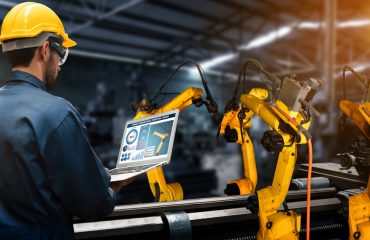How many times over the past couple of years have you gone to the store only to find out that it’s out of your favorite Captain Lucky Fruit Smacks cereal? Or maybe it’s your go-to bag of Salty Nacho Crispy snacks.
Whatever it is you crave on a regular basis, there’s a good chance your local store has been out of it more than once since the COVID-19 pandemic began. Whole sections of empty store shelves have become the norm, rather than the exception. What’s going on?
As any store manager is likely to tell you, ongoing supply chain disruptions have wreaked havoc throughout every industry. From food and electronics to automobiles and paper products, consumers have gotten used to not always being able to get what they want when they want it.
In this article, we’ll take a closer look at recent supply chain disruptions and what steps manufacturers are taking to avoid them in the future, including embracing new automation technologies. We’ll also examine the role training plays in getting new logistics technicians up to speed on the latest technologies and how Amatrol’s Skill Boss Logistics trainer can help prepare the next wave of students and workers to tackle supply chain issues head on.
Supply Chain Disruptions and the Toll They’re Taking on Manufacturers
How bad have supply chain disruptions been for the manufacturing industry? According to National Association of Manufacturers (NAM) President and CEO Jay Timmons, “[m]anufacturers have shown incredible resilience through multiple crises, but the challenges of…supply chain strains…are taking a toll.”
NAM’s recent Manufacturers’ Outlook Survey for the third quarter of 2022 revealed declining optimism amongst manufacturers, and supply chain disruptions were one of the primary reasons cited. For example, the survey found that “78.3% of manufacturing leaders listed supply chain disruptions as a primary business challenge with only 10.8% believing improvement will occur by the end of the year.”
What manufacturers — and the public at large — have learned over the past few years of the pandemic is how interconnected of a web the global supply chain truly is. When COVID-19 shut down electronics plants in China for months at a time, the supply of critical microchips dried up rapidly, leaving thousands of automobiles stuck in production waiting on chip production to resume.
The same story repeats over and over in industries across the board and around the globe. Many manufacturers find themselves unable to complete production of new products because they’re waiting on essential parts. In turn, they create the same type of problem for other manufacturers or retailers waiting on those products. It quickly became a vicious cycle that has been hard to break.
Automation to the Rescue
Over the past century, industry has repeatedly turned to the same type of solution when faced with seemingly-insurmountable challenges: technology. Today’s supply chain woes are no exception.
Facing increasing supply chain disruptions while also experiencing unprecedented labor shortages, many industries have turned to advanced automation technologies to increase productivity and efficiency. Experts often refer to these new advanced automation technologies by a variety of names, including smart manufacturing, Industry 4.0, and the Industrial Internet of Things (IIoT).
In a recent Talking Logistics article, author Pervinder Johar notes that “[i]t is widely accepted that digitization is the key to transforming all areas of the logistics industry.” He goes on to explain the importance of new technologies in solving today’s supply chain issues:
“The Internet of Things (IoT) represents a new wave in the industrial revolution that will transform the entire supply chain ecosystem. IoT-enabled visibility not only provides the ability to respond to supply chain distributions in real-time, but it also enhances other emerging technologies such as artificial intelligence (AI) and machine learning (ML). IoT is a key component in taking supply chain technology to the next level.”
But exactly how will IoT improve the supply chain? Johar gives an example:
“The implementation of IoT devices…can provide an enhanced real-time visibility experience. They can accurately track the location and condition of goods, enabling better reservation or repositioning decisions…They also replace asset tracking methods like barcodes and identify points of delay, providing more time for contingency planning.”
In this way, “IoT…can help eliminate supply chain blind spots via true real-time data insights, thus making supply chains more agile and resilient.” Moreover, any industry with logistics challenges can benefit. As Johar notes, “[t]he applications are limitless across a variety of industries from perishables to high-tech…the logistics industry will undergo an immeasurable revolution over the next decade with the help of IoT technology.”
New Technologies Highlight Shortage of Qualified Logistics Technicians
As industries everywhere move forward with the implementation of new advanced automation technologies, they’re soon discovering that they’re also either creating or making worse a different problem: there simply aren’t enough highly-skilled logistics technicians available.
When an industry turns to a new IIoT technology solution, they also need workers skilled in the operation, maintenance, troubleshooting, and repair of these advanced technologies. Unfortunately, the supply of skilled logistics technicians is falling far short of the increasing demand for them.
That’s why so many industries are taking a two-pronged approach to solving this problem: (1) training current workers with the Industry 4.0 skills they need to succeed; and (2) establishing relationships with local educational institutions to make sure they’re teaching the skills students will need to hit the ground running in a new career.
To be as effective as possible, the training that students and current workers receive should include hands-on skill development with industrial components they’ll encounter in the workplace. To ensure current and future workers have these skills, industries are increasingly relying upon industry certifications that validate hands-on skills.
How Amatrol Takes Logistics Training to the Next Level
If you’re an educator looking to adequately train the next generation of logistics technicians or an employer needing to upskill your current workforce, you don’t have to recreate the wheel when it comes to hands-on logistics skill training with advanced automation technologies.
Look no further than Amatrol’s Skill Boss Logistics, a supply chain automation training and assessment device that promises to bridge the skills gap by increasing the number of technicians with the skills needed to survive and thrive in today’s supply chain automation and material handling industries.
Click below to see Skill Boss Logistics in action:
Amatrol developed Skill Boss Logistics in collaboration with the Manufacturing Skill Standards Council (MSSC) to support its new Certified Technician in Supply Chain Automation (CTSCA) certifications. These new certifications will enable both students and current workers to gain the skills needed to work effectively as a supply chain automation technician.
Skill Boss Logistics Teaches Hands-On Skills
Skill Boss Logistics is a real working automated distribution system. It teaches and assesses 100 hands-on skills essential for today’s technicians. For example, Skill Boss Logistics performs the following supply chain and material handling operations:
- distribution of packages to three different destinations;
- 2D barcode package tracking;
- automatic package queuing and priority release;
- electro-pneumatic sorting;
- vertical package sorting;
- conveyor material handling;
- jam sensing;
- product gap optimization;
- package data tracking and control; and
- package rework and recirculation.
Importantly, Skill Boss Logistics features real industrial equipment that supply chain automation technicians will encounter on the job. Featured components include the following:
- programmable logic controller (PLC);
- Ethernet network with managed switch;
- AC and DC electric variable speed motors;
- PC-based human-machine interface (HMI);
- 2D barcode scanner;
- photoelectric, thru-beam, retro-reflective, diffuse, inductive, limit switch, and magnetic reed sensors;
- vacuum lift electro-pneumatic manipulator;
- multiple belt and roller conveyors;
- induction conveyor;
- variable speed distribution conveyor; and
- multiple discharge chutes.
 The PC-based HMI allows users to oversee the entire system’s operation and performance via Warehouse Control System software. All of these real industrial components are included in an easy-to-use, compact system that will fit neatly into any classroom. The system is also easy to transport for use across multiple sites within a company or school system.
The PC-based HMI allows users to oversee the entire system’s operation and performance via Warehouse Control System software. All of these real industrial components are included in an easy-to-use, compact system that will fit neatly into any classroom. The system is also easy to transport for use across multiple sites within a company or school system.
Skill Boss Logistics also features Amatrol’s exclusive FaultPro computer-based fault insertion software. The industry’s only electronic troubleshooting training system, FaultPro allows instructors to insert more than 45 real-world faults to test a learner’s weaknesses and turn them into strengths.
If you’re ready to take your logistics training to the next level, consult with an expert at Amatrol today to learn how you can take the first step toward teaching the skills that will set students up for success in the future.
About Duane Bolin
Duane Bolin is a former curriculum developer and education specialist. He is currently a Marketing Content Developer in the technical training solutions market.





